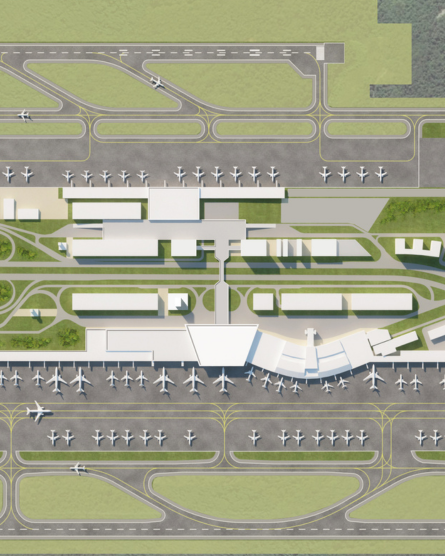Large airport projects are like alpine crossings: long, complex, and risky. This article highlights key lessons for managing teams, complexity, and uncertainty in such unique and demanding project situations.
Complex large-scale projects are incredibly exciting construction tasks, but they are also very demanding. The feedback from the planning participants can often be summarised in one expression: „Too much and too many!“
- Too many open topics
- Too many participants
- Too many meetings
- Too many (conflicting) requirements
- Too many difficult conditions
Under such working conditions, even experienced planners with a lot of professional experience will eventually reach their limits. At the start of the planning, things often seem manageable, but soon the number of open issues grows, and the overview is gradually lost. Eventually, the entire project can get out of control. The atmosphere becomes increasingly stressed, and in the worst case, real interpersonal or even legal conflicts arise.
Due to the constant overload, the project status in large projects is often at „red“. Additionally, large projects are also „marathon projects“, and it can sometimes take as long as 20 years from the architectural competition to completion, like with Terminal 3 at Frankfurt Airport.
Challenges in Planning Large Projects
Planning large projects faces challenges that go beyond the experiences of typical planning work for residential buildings, office buildings, or even smaller public buildings, like schools.
Typical situations in the early phases of large projects include:
- Increased complexity: The initial situation for the client is highly complex, with extensive descriptions of requirements and conditions. However, the more one engages with these, the more contradictions appear.
- Great uncertainty: The start of the planning work requires an above-average amount of „project development work“. The degree of uncertainty and ambiguity is greater in all aspects than one is used to in other projects – it concerns everything, such as goals, content, deadlines, and costs.
- Challenging specialist topics: Often, special construction tasks lead to above-average demanding planning challenges that require a lot of specialist knowledge, which must be developed first (e.g. in hospital or airport construction).
- Keeping an overview: The amount of topics to be worked on and the number of participants is far greater than usual. This results in many more meetings, which eventually have to run in parallel. Keeping an overview becomes a challenge that can no longer be handled „on the side“ by the project manager. In one of my previous terminal planning projects, for example, there were weeks with 20 meetings and around 40 participants from four countries across three different time zones.
- High planning volume: The volume of planning work to be completed is much higher than participants are accustomed to. Information management also becomes much more difficult due to the volume of data and participants. At the same time, this cannot be solved simply by adding more staff, money, or time.
- Demanding decision management: Decisions in such projects are much more demanding due to the complexity. They take longer and require careful preparation, which usually involves both content-related and „political“ components.
Risks of Large Projects: Complete Failure!
Due to the complexity, high project costs and fees, as well as long durations, the risks for the involved planners are much greater than in usual projects. Not just financially, but also psychologically: For example, it is much more common for key employees to leave the project in frustration. Finding replacements with sufficient experience is harder than usual.
In two cases, I witnessed entire specialist planning firms going bankrupt due to legal conflicts within the project. In one case, this caused the entire project to be delayed by several months. In others, it led to tragic professional and personal consequences for certain individuals. I myself nearly slipped into a burnout a few years ago as the project manager of a very complex project.
Everyone Has an Opinion – And Thinks They Know Better
In public large projects, the media and politics often have a much stronger say, unfortunately not always from a professional perspective. Influential entities quickly call for seemingly „simple“ solutions. In the case of Berlin’s BER Airport, for example, countless press reports and reader comments suggested that it was simply a matter of hiring the „right“ managers and more suitable engineers, and that the planners had „forgotten“ to consider something that should have been obvious. Project participants were accused of having an interest in delays and cost increases.
This „everyone having an opinion“ cannot be prevented and must therefore be considered by the project team from the start. On the one hand, individuals at the top of the project need to be capable of managing „political relationship work“ with all important stakeholders and decision-makers. On the other hand, larger decisions must be prepared much more carefully and communicated differently, something that is often underestimated by planners.
Large Projects Are More Like Crossing the Alps Than a Walk in the Park
In my talks, I like to use the following analogy: Normal construction projects have the character of „multi-day hikes“, they are manageable, and their progress is usually predictable. Large projects, on the other hand, are „Alpine crossings“: they are more exciting and appealing, especially for experienced planners, but they are also much longer, more exhausting, more complicated, and, above all, much more uncertain and riskier.
Good mountaineers know: Only careful preparation reduces risks and increases the enjoyment of the journey! Multi-day tours in the high mountains mean:
- On the one hand, you need an overall route in mind, but you must check it at every stop.
- There is at least one Plan B, even better, a Plan C.
- There is enough time for preparation. Between stops to check the route, all plans are known to everyone (you don’t set off and only realise after a few kilometres that…).
- The team must have enough experience for such a challenge. Ideally, not just with the task at hand, but also in working together.
- Every team member dedicates 100% of their time to the project. There are no „part-time mountaineers“ who are also involved in three other projects.
All elements of this strategy can be directly applied to large projects. The frequently experienced approach of „Let’s just start and do it as usual, but with a bigger team“ is, however, doomed to fail.
Every Large Project Is Different
The range of different conditions in large projects is much greater than one might usually expect:
My previous project (planning Terminal Noida International Airport, India) and my current project (Terminal Dock A, Zurich Airport), for example, are both within the same client organisation (Zurich Airport is building and financing the Noida Airport). But the similarities end there:
- Noida is a project like a „speedboat“. Very tight deadlines, a small organisation, short decision-making paths, building on greenfield sites, a robust and simple building structure. Additionally, the planning was done 90% through online meetings due to Covid-19.
- The project in Zurich, on the other hand, is the complete opposite, more like an „aircraft carrier“: highly complex, even larger, many more participants, 90% of meetings are held in person, building in the middle of airport operations, exciting but very difficult-to-implement building structure, long project duration.
Clients and planners should therefore adapt the project setting to the specific conditions and prepare it carefully (…you would do the same for an Alpine crossing, wouldn’t you?). Only by acknowledging the unique nature of large projects and adjusting accordingly can the inherent risks be minimised, and the success of the project made more likely. The key lies in preparing for and managing the complexity of such projects.


